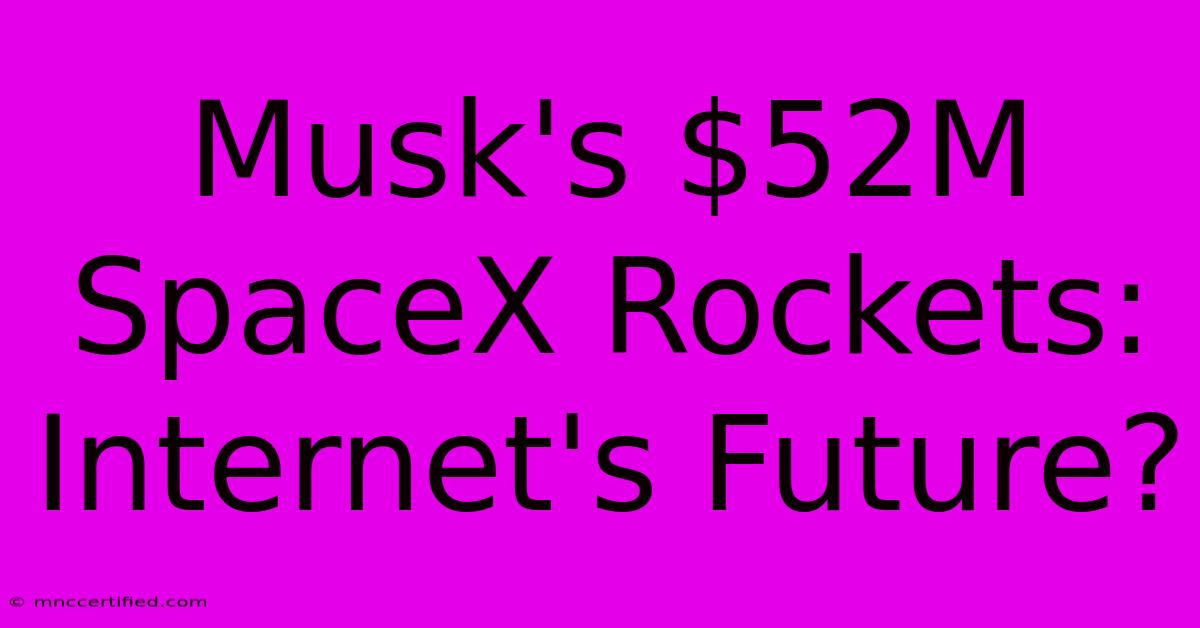Musk's $52M SpaceX Rockets: Internet's Future?

Table of Contents
Musk's $52M SpaceX Rockets: Internet's Future?
Elon Musk's SpaceX is aiming to revolutionize internet access with its ambitious Starlink project. The company plans to launch thousands of low-Earth orbit (LEO) satellites, creating a global network capable of providing high-speed, low-latency internet to even the most remote corners of the world. But the question remains: can these $52 million rockets be the key to unlocking the internet's future?
The Promise of Starlink
The potential of Starlink is undeniable. Imagine having consistent, reliable internet access no matter where you are, whether you're in a remote village, a bustling city, or even on a plane. This is the vision SpaceX aims to achieve with its constellation of satellites.
Starlink's key advantages:
- Global coverage: Reaching areas currently underserved by traditional internet infrastructure.
- High speed: Offering download speeds up to 200 Mbps, surpassing many terrestrial internet providers.
- Low latency: Delivering faster response times, crucial for gaming, video conferencing, and other real-time applications.
The Cost Factor
While the promise of Starlink is enticing, the reality is that it comes at a significant cost. Each Falcon 9 rocket, capable of carrying dozens of Starlink satellites, costs around $52 million. Launching thousands of satellites into orbit will require a substantial investment, raising questions about the project's long-term viability.
The Competition Heats Up
SpaceX is not alone in its quest for global internet domination. Companies like Amazon's Project Kuiper and OneWeb are also developing their own LEO satellite constellations, creating a fiercely competitive market.
Key factors influencing the competition:
- Deployment speed: The ability to launch satellites rapidly and efficiently.
- Satellite technology: Innovation in satellite design and performance.
- Pricing and accessibility: Providing affordable and accessible internet services.
The Future of Internet Access
Ultimately, the success of Starlink and other LEO satellite constellations hinges on their ability to deliver on their promises: affordable, reliable, and high-speed internet access for everyone.
Here are some crucial factors to consider:
- Regulations and licensing: Ensuring a smooth and equitable deployment of satellite networks.
- Technological advancements: Continued innovation in satellite technology and network management.
- Customer adoption: The demand for satellite internet services and user satisfaction.
While the future of internet access is still being written, SpaceX's Starlink project represents a significant leap forward. The company's ambitious vision and technological advancements have the potential to bridge the digital divide and unlock a new era of global connectivity.
As the race for space-based internet intensifies, it will be fascinating to see how Starlink and its competitors shape the future of the online world.

Thank you for visiting our website wich cover about Musk's $52M SpaceX Rockets: Internet's Future?. We hope the information provided has been useful to you. Feel free to contact us if you have any questions or need further assistance. See you next time and dont miss to bookmark.
Featured Posts
-
Karla Sofia Gascon Emilia Perezs Right Hand
Nov 14, 2024
-
Trump Taps Hegseth For Defense Secretary Role
Nov 14, 2024
-
Whoopi Goldbergs Italy Travel Picks
Nov 14, 2024
-
Essex Mortgage Insurance Department
Nov 14, 2024
-
How To Accept Insurance As A Massage Therapist
Nov 14, 2024